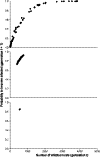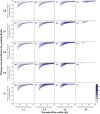Coinfecting parasites can modify fluctuating selection dynamics in host-parasite coevolution
- PMID: 33005333
- PMCID: PMC7520197
- DOI: 10.1002/ece3.6373
Coinfecting parasites can modify fluctuating selection dynamics in host-parasite coevolution
Abstract
Genetically specific interactions between hosts and parasites can lead to coevolutionary fluctuations in their genotype frequencies over time. Such fluctuating selection dynamics are, however, expected to occur only under specific circumstances (e.g., high fitness costs of infection to the hosts). The outcomes of host-parasite interactions are typically affected by environmental/ecological factors, which could modify coevolutionary dynamics. For instance, individual hosts are often infected with more than one parasite species and interactions between them can alter host and parasite performance. We examined the potential effects of coinfections by genetically specific (i.e., coevolving) and nonspecific (i.e., generalist) parasite species on fluctuating selection dynamics using numerical simulations. We modeled coevolution (a) when hosts are exposed to a single parasite species that must genetically match the host to infect, (b) when hosts are also exposed to a generalist parasite that increases fitness costs to the hosts, and (c) when coinfecting parasites compete for the shared host resources. Our results show that coinfections can enhance fluctuating selection dynamics when they increase fitness costs to the hosts. Under resource competition, coinfections can either enhance or suppress fluctuating selection dynamics, depending on the characteristics (i.e., fecundity, fitness costs induced to the hosts) of the interacting parasites.
Keywords: Red Queen dynamics; coevolution; coinfection; resource competition; virulence.
© 2020 The Authors. Ecology and Evolution published by John Wiley & Sons Ltd.
Conflict of interest statement
We declare we have no competing interests.
Figures





Similar articles
-
Parasite transmission among relatives halts Red Queen dynamics.Evolution. 2017 Mar;71(3):747-755. doi: 10.1111/evo.13157. Epub 2017 Jan 5. Evolution. 2017. PMID: 27996079
-
The role of defensive symbionts in host-parasite coevolution.Biol Rev Camb Philos Soc. 2018 Nov;93(4):1747-1764. doi: 10.1111/brv.12417. Epub 2018 Apr 16. Biol Rev Camb Philos Soc. 2018. PMID: 29663622 Review.
-
Novel genomic approaches to study antagonistic coevolution between hosts and parasites.Mol Ecol. 2021 Aug;30(15):3660-3676. doi: 10.1111/mec.16001. Epub 2021 Jun 22. Mol Ecol. 2021. PMID: 34038012 Review.
-
Do Coinfections Maintain Genetic Variation in Parasites?Trends Parasitol. 2016 Dec;32(12):930-938. doi: 10.1016/j.pt.2016.08.010. Epub 2016 Sep 7. Trends Parasitol. 2016. PMID: 27614425 Review.
-
Microbial protection favors parasite tolerance and alters host-parasite coevolutionary dynamics.Curr Biol. 2022 Apr 11;32(7):1593-1598.e3. doi: 10.1016/j.cub.2022.01.063. Epub 2022 Feb 10. Curr Biol. 2022. PMID: 35148861 Free PMC article.
Cited by
-
Coevolutionary theory of hosts and parasites.J Evol Biol. 2022 Feb;35(2):205-224. doi: 10.1111/jeb.13981. Epub 2022 Jan 30. J Evol Biol. 2022. PMID: 35030276 Free PMC article. Review.
-
A Conceptual Disease Cycle Model to Link the Size of Past and Future Epidemics.Ecol Evol. 2025 Jul 28;15(8):e71868. doi: 10.1002/ece3.71868. eCollection 2025 Aug. Ecol Evol. 2025. PMID: 40740800 Free PMC article. Review.
References
-
- Agrawal, A. , & Lively, C. M. (2002). Infection genetics: Gene‐for‐gene versus matching‐alleles models and all points in between. Evolutionary Ecology Research, 4, 79–90.
LinkOut - more resources
Full Text Sources

